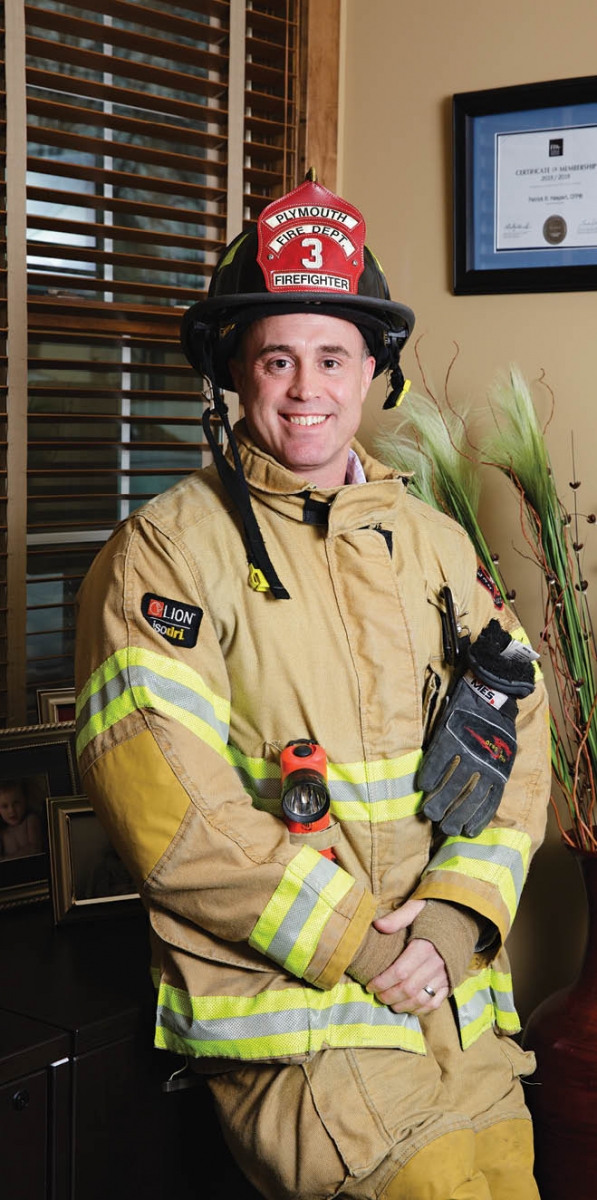At any given time, there are about 70 local residents—teachers, carpenters, real estate agents, insurance salesmen and business owners—carrying a pager 24/7, trained and ready to assist the Plymouth Fire Department with emergencies at a moment’s notice.
Meet the paid on-call firefighters of Plymouth.
“There are many people who refer to them as volunteer firefighters,” says Dave Dreelan, deputy fire chief. “But although they don’t get paid a lot, they do get paid. And once they put on their gear, get on the truck and respond, there’s virtually no difference between them and a career firefighter.”
After a rigorous interview process and first year of training that typically involves 60-80 hours per month, each on-call firefighter works an average of 10-15 hours a week. That includes time spent attending outreach events and training sessions, working duty crew shifts at the station, and assisting the department’s six full time staff members with emergency rescue ranging from fire calls to water and ice rescues.
Ann Korsmo, 40, preschool teacher, recently married, and now stepmom to a 10-year-old, has been an on-call paid firefighter for 16 years. Her interest was sparked while being evacuated when her college dormitory was on fire.
“I remember standing there, watching the trucks roll in and the firefighters hopping off the truck. I couldn’t even move. I was so fascinated by how they worked together as a team and all their assignments going on at once,” Korsmo says.
A few years later, while working in her first job as a teacher, she saw an ad in the Plymouth paper promoting the recruitment and training of on-call firefighters and decided to give it a try. “I was sure I’d never pass the agility test. I saw all these burly men and assumed you had to look like them, but I thought it would be a cool story to tell my kids someday that at least I interviewed to be a firefighter.”
She did pass the agility test, was sworn in during the fall of 2000, and has been a devoted member of the on-call crew ever since.
“It complements my fulltime job. Being a teacher for preschoolers who thrive on routine can get very monotonous. In my role as firefighter, you have no idea what it’s going to bring,” Korsmo says. “It’s not all running around town with our lights and sirens to flames and smoke everywhere. But with all the continuous training and outreach programs we’re involved in, there’s always something different going on.”
For any rescue worker, it’s often that first fire, that first tragedy, that stands out in their memories the most. For Korsmo, that first was a fatal accident on Interstate 494 in which a Jeep Wrangler with its top down, carrying three or four college kids, flipped over. Two died at the scene and one died at the hospital, according to Korsmo.
“It was the first time I’d seen real life trauma. I hadn’t yet completed my medical training, so I was forced to stand back and as a result, I had the time to take it all in and it was surreal. I was standing in the middle of the highway, cars were shut down in all directions around us. Everything to me felt like it was in slow motion but happening so fast at the same time. I remember thinking, wow, this might not be for me. This is too much. You just can’t wrap your head around what you’re seeing,” Korsmo says.

For others, like Patrick Haspert, 42, a financial planner and father of two little girls, coming to the rescue is in their blood. “We hope we’re never needed, but when we are, we step up and help,” says Haspert, who comes from a long line of rescue workers including a brother who is a police officer and a half dozen relatives who are either current or retired firefighters.
Haspert, sworn in in October 2015, recalls his first emergency response. “It was a car fire at a local gas station. It was exciting and scary, everything you can imagine,” he says. But for him, personally, the most affecting moment so far was something a dad said to him and a few of the other firefighters while representing the Fire Department at an open house at the Wayzata Learning Center.
“He came up to us and said, ‘I just want to shake all of your hands and thank you for what you do for the community and what you did for me. I was in an accident, and my arm was pinned. If it wasn’t for Plymouth Fire and how careful you all were at getting me and my arm out, I would have lost my arm. I wouldn’t be able to hold my kids.’”
Haspert was not part of that particular rescue, nor does he know which firefighters were. “But hearing that was the single proudest moment I’ve had since being part of this department,” he says. “The collective commitment we all have is powerful, and I’m just very, very happy to be a part of it.”
For both Korsmo and Haspert, it’s the camaraderie with the other firefighters that makes all the difference.
“Most of the laugh lines on my 40-year-old face are from the other firefighters,” Korsmo says. “During those lulls at the station, they always keep me laughing. It’s a really neat group of people who look out for each other.”
“Through the time we spend in training, in duty crew, and on the calls we make, you have opportunity to get to know these people in a lot deeper way than you normally would,” Haspert says.
The recruitment of on-call paid firefighters is a challenge, according to Dreelan. “Once they fully understand the commitment that’s required, it forces them to make a difficult decision. It’s not uncommon to lose people in the hiring process the more they learn about the time and energy it takes,” Dreelan says.
“When I first joined, I was 24, didn’t have any kids at home, and could put in as much time as I wanted.” Korsmo says. “But now, I’m getting to the age where I need to find balance, make time for me and the people I love.”
“When I first signed up, I only had one child, and it was rather easy to manage my time between my day job, my family, and learning to become a firefighter,” Haspert says. “But now I have a second child and my business is busier.”
Despite the difficult choices and sacrifices they’ve had to make to fit in this extra commitment, Korsmo and Haspert agree it’s been one of the most amazing experiences of their lives.
“It’s given me thicker skin, which I needed. It’s taught me to look out for others and given me skill sets that have been really valuable. I’ve been able to use my training when I’ve come across people needing medical help. Even in in my own house, some of the mechanical skills I’ve been taught have helped me be more industrious,” says Korsmo.
“There’s something inherently satisfying about being with those serving in the same capacity as you are,” Haspert says. “Without question, being a firefighter is one of the most rewarding things I could’ve done.”
The hiring process is typically conducted annually in late spring and early summer and takes several months to complete. Applicants must be at least 18 years old, have a high school degree or equivalent, and reside within an eight-minute travel time to one of Plymouth’s three fire stations. After filling out an application, there are a series of interviews, background checks, medical exams and a physical fitness test. If applicants make the cut, they begin their rigorous first year of training and shadowing.
Paid on-call firefighters are compensated for all activities. They receive an hourly rate range from $11.50 to $14.50, depending on rank and level of responsibility.
According to Dreelan, the ones who push through the initial training and persevere long-term do so because they are looking to become part of something bigger, for a challenge they may not get in other aspects of their life.
“It takes a special kind of person to do this job and balance the needs of the community with their fulltime careers and families,” says Dreelan.









